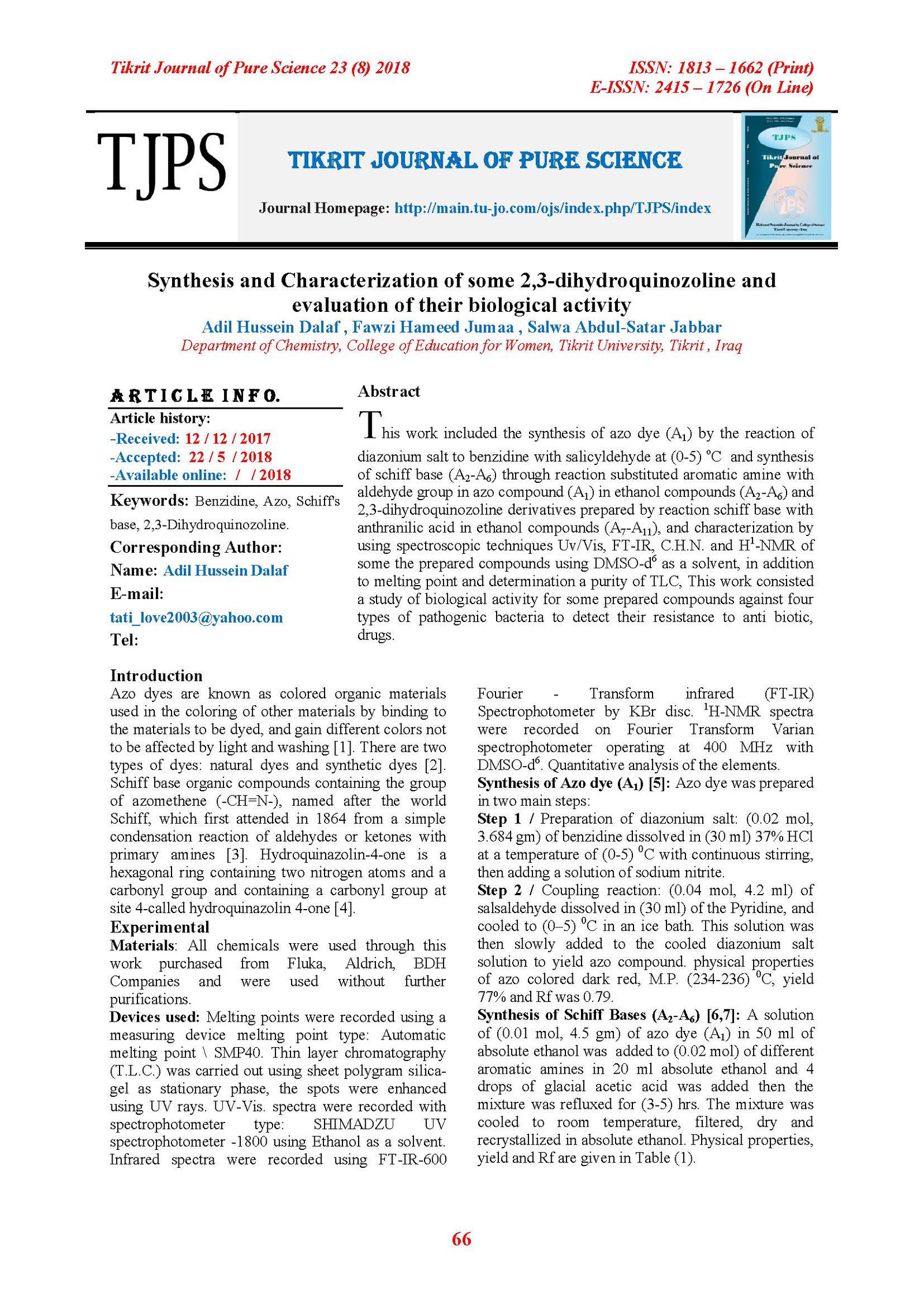Synthesis and Characterization of some 2,3-dihydroquinozoline and evaluation of their biological activity
Main Article Content
Abstract
This work included the synthesis of azo dye (A1) by the reaction of diazonium salt to benzidine with salicyldehyde at (0-5) oC and synthesis of schiff base (A2-A6) through reaction substituted aromatic amine with aldehyde group in azo compound (A1) in ethanol compounds (A2-A6) and 2,3-dihydroquinozoline derivatives prepared by reaction schiff base with anthranilic acid in ethanol compounds (A7-A11), and characterization by using spectroscopic techniques Uv/Vis, FT-IR, C.H.N. and H1-NMR of some the prepared compounds using DMSO-d6 as a solvent, in addition to melting point and determination a purity of TLC, This work consisted a study of biological activity for some prepared compounds against four types of pathogenic bacteria to detect their resistance to anti biotic, drugs.
Article Details

This work is licensed under a Creative Commons Attribution 4.0 International License.
Tikrit Journal of Pure Science is licensed under the Creative Commons Attribution 4.0 International License, which allows users to copy, create extracts, abstracts, and new works from the article, alter and revise the article, and make commercial use of the article (including reuse and/or resale of the article by commercial entities), provided the user gives appropriate credit (with a link to the formal publication through the relevant DOI), provides a link to the license, indicates if changes were made, and the licensor is not represented as endorsing the use made of the work. The authors hold the copyright for their published work on the Tikrit J. Pure Sci. website, while Tikrit J. Pure Sci. is responsible for appreciate citation of their work, which is released under CC-BY-4.0, enabling the unrestricted use, distribution, and reproduction of an article in any medium, provided that the original work is properly cited.
References
[1] Angelini, L.G.; Pistelli, L.; Belloni P. and Panconesi, S. (1997). Industrial crops and products., 6 (3):303-312.
[2] Al-Banis, T.A.; Hela, D.G.; Sakellarides, T.M. and Danis T.G., (1996). Global NEST J.", 2(3):237-241.
[3] Ali, Y.; Habib, M.J.A. and Al-Janabi, K.W. (1996). Iraqi J. Chem., (21):104.
[4] Naser, A.W. (2013). Iraqi National Journal of Chemistry., (50):199-206.
[5] Al-Hassani, R.A.M. (2016). Baghdad Science Journal., 13 (4):793-805.
[6] Faraj, F.L.; Ali, W.B.; Jassim, S.A. and Ali, T. R. (2017). Diyala Journal for Pure Science., 13 (2) 1:262-277.
[7] Chenjie, B. (2017). Current Organic Synthesis., 14 (4):582-589.
[8] Lfta, S.J.; Ayram, N.B. and Baqer, S.M. (2016). Journal of Al-Nahrain University Science., 19 (1):1-12.
[9] Garrol, L.; lambert, H.; Grady, D. and Water, W.P. (1981) Antibiotic and Chemotherapy. 5th edn., Churchill Livingstone New York.
[10] Mahendra, K.R. (2017). Journal of Chemical, Biological and Physical Sciences (JCBPS)., 7(2):334.
[11] Roa, C.N.R. (1961). Ultra Violet and Visible Spectroscopy Chemical Application., Butter–Woths Ltd., 52.
[12] Sorates, G. (1980). Infrared Characteristic group Freqyencies. John Wiely and Sons. Ltd.
[13] Vogle, I. (1972). Text-book for practical organic chemistry 3th ed., Longman.
[14] Silverstein, R.M. (1998). Spectrometric Identification of Organic Compounds. 7th ed., John Wiley and Sons, New York.
[15] Bruce, P.Y. (2008). Organic Chemistry 4th ed., Prinitic– hall lnc. Uppe Sadale River New Jersey.
[16] Al-Bayati, R.I. (2013). Al-Mustansiriyah Journal of Science., 24 (3):33-40.
